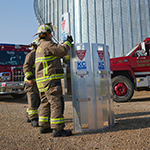Return-to-work program
Learn how to create a workers' compensation return-to-work program.
When an employee is injured at work and has a lengthy recovery period, there are typically three main concerns: your employee, your business and your workers’ compensation premium. Workers’ compensation claims involving time-off work can drive up claims costs, which in turn drive up the rates by increasing your experience mod.
See Understanding Your Worker’s Compensation Premium.
As medical costs continue to accelerate, your business is exposed to increasing workers’ compensation, medical and legal expenses. One proven cost-saving measure is the development and implementation of an effective return-to-work program.
A return-to-work program is an employer-implemented program designed to return injured, disabled or temporarily impaired workers to the workplace as soon as medically possible. Beneficial to both the injured employee and your company, a return-to-work program should be an important part of your business strategy to retain valued employees, enhance productivity and assist in a favorable bottom line.
Historically, return-to-work programs have been associated with returning employees from occupational injuries only. Today, successful return-to-work programs are integrating non-occupational injuries into a comprehensive disability management strategy that includes management, human resources, safety personnel and employees working together.
Direct costs vs. indirect costs with workers' comp claims
Besides the cost of your workers’ compensation premium, there are other costs associated with a claim. The cost of any workers’ compensation claim can be broken down into either direct or indirect costs. Direct costs are associated with the insurable cost of the claim and include costs for medical care (e.g., doctor visits, physical therapy, medicine, etc.), payments for time-off work mandated by state law and any other state-mandated costs (e.g., vocational rehab, mileage for appointments, etc.). Direct costs are usually paid by the insurance company. If you have a deductible program, then you would pay that portion of the direct cost of the claim.
Indirect costs are those the business pays. Indirect costs are uninsurable costs to the business and involve things like reduced productivity, administrative costs, accident investigations, supervisor follow-ups, hiring a replacement worker, training a replacement worker, overtime, equipment repair/replacement, benefits paid to the employee while off work, health insurance, time for an Occupational Safety Health Administration (OSHA) investigation (if necessary), OSHA penalties (if any), time to contest OSHA penalties (if applicable), negative publicity, damage to customer relations and employee turnover. According to OSHA, indirect costs are 1.5 to 7 times the cost of the claim.
Return-to-work benefits
Return-to-work simply means helping your employee get back to work as soon as possible after an injury or illness. For example, if a returning employee’s job requires the ability to lift 25 pounds, but the employee has a 10-pound lifting restriction, an effective return-to-work program would allow the employee to temporarily perform a different job or only part of the original job.
Medical providers work in cooperation with employers to help develop modified work restrictions that are appropriate for each individual. Return-to-work programs are most successful when employers take a proactive role in establishing relationships with local medical providers and begin to develop a program before one is needed.
For the employer, in addition to reducing claims costs and insurance premiums, an effective return-to-work strategy:
- Encourages communication between management and employees
- Allows employees to continue working
- Keeps loss of productivity to a minimum
- Reduces the cost of recruiting, on-boarding and training new employees
- Creates an opportunity to complete work usually left undone
- Shows that you value employees and their contributions
For the employees, an effective return-to-work strategy:
Preserves long-term earning power
- Keeps employees active and speeds medical recovery
- Shifts the focus from disability to ability
- Reduces the risk of re-injury (in some cases)
- Provides a sense of job security
- Allows employees to maintain contact with co-workers
- Reduces the long-term effects of disability, such as emotional isolation and depression
Elements of a return-to-work program
Your company should develop a written return-to-work policy and procedures so that everyone understands what is expected. A return-to-work policy states your commitment to returning employees to work. Return-to-work procedures spell out each person’s responsibility in the process, including safety personnel, human resources, supervisors and employees.
Communication is key to a successful return-to-work program. After an injury has occurred and the injured employee has received medical care, management should call or visit the injured worker within 24 hours. Communication helps reassure the employee that the company is sincerely concerned about his/her well-being. Inform the employee of his/her rights and responsibilities as an injured worker, answer any questions or concerns the employee may have and, when appropriate, explain the return-to-work process. Maintain frequent contact with the employee throughout the term of the injury or illness.
It’s also important for you to discuss your return-to-work program with the attending physician. Unless you discuss restricted-duty options, the physician may assume there’s no alternative available. When restricted duty isn’t an option, statistics prove it often results in an extended period of doctor-approved disability. Provide the physician with the injured employee’s written job description, which should detail the physical demands of the employee’s regular job. Include a letter that notifies the physician of the availability of restricted duty assignments and indicate that your company can assist in the employee’s recovery.
Modified duty for injured employees
Modified duty allows an injured employee to return or remain at work, performing physically-appropriate duties. Job modifications are developed and implemented based on the injured employee’s limitations, restrictions, functional capacity and physical capabilities. For the employer, this means:
- Comparing the employee’s functional capabilities to the job requirements
- Deciding to what extent the job can be modified
- Identifying other modified-duty opportunities on a limited or full-time basis, if modification of the employee’s original job is not possible
Other considerations for the development of job modifications include:
- Taking a positive approach and focusing on what employees can do, rather than tasks they can’t perform
- Assigning meaningful duties, allowing injured employees to maintain their dignity
- Revising current job descriptions to include only necessary tasks
- Assigning tasks that may have been put off because nobody had time to do them — tasks that are not currently being performed, or jobs that are being done only occasionally, such as inventorying supplies, reviewing old files, organizing the library or updating plans
- Temporarily reassigning tasks to free up other employees
- Ensuring that employees and their co-workers fully understand that this is temporary work, and that injured employees will be expected to return to their full jobs as soon as medically able
- Reviewing the assignment regularly, in cooperation with the claim representative and treating physician
Employees performing modified duty need close supervision and monitoring. They also need to be directed to stay within their limits. As an employer, you must make injured workers aware of what modified duties include and that they are expected to return to their full jobs as soon as they’re medically able. Modified duty should last no more than a few months.

 >
>

 >
>
 >
>